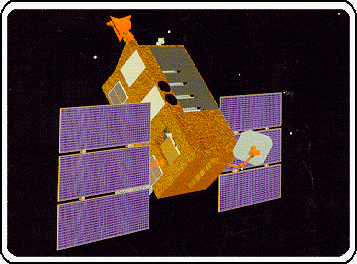 |
 |

Below is a sample schedule for an RXTE observation. We've added notes to interpret what the different sections mean.
[1] 1998:264:14:43:00 149006583 OBSERVATION 30103-01-06-00 START
[2] PI: PABLO REIG
[3] SOURCE: EXO_2030+375
[4] TARGET: RA=308.062988 DEC=37.638000 ROLL_BIAS=-9.2 SLEW_RATE=6.0
[5] EDS: GOODXENON1_2S
GOODXENON2_2S
Null
Standard1b
Standard2g
Null
[6] HEXTE: E_8US_256_DX1F (LLDA=DEF DWELLA=DEF ROCKA=DEF)
E_8US_256_DX1F (LLDB=DEF DWELLB=DEF ROCKB=DEF)
[7] EVENTS: start_slew 14:43:00 (149006583)
end_slew 14:52:00 (149007123)
out_saa 14:52:00 (149007123)
in_occult 15:47:00 (149010423)
in_saa 16:10:00 (149011803)
out_occult 16:24:00 (149012643)
out_saa 16:28:00 (149012883)
[8] GOODTIME: 14:52:00 (149007123) to 15:47:00 (149010423)
16:28:00 (149012883) to 17:23:00 (149016183)
[9] TOTAL_GT: 6.6 ksec
[10] 1998:264:17:23:00 149016183 OBSERVATION 30103-01-06-00 END
Notes:[1] This line gives the start time of the observation. It is first given as year:day of year:hours:minutes:seconds. This time is given in Universal Time. The second large number is the RXTE Mission Elapsed Time, which is the number of seconds since Jan 1, 1994. This is followed by an observation ID number.
[2] "PI" stands for "Principal Investigator". This is the name of the astronomer who proposed this observation. The data resulting from this observation will be his/hers for one year, and then it will be made available for anyone to look at.
[3] This is the name of the source being observed.
[4] This line gives the location of the source in Right Asencsion (RA) and Declination (DEC). It also gives the roll angle of the satellite, and the speed with which the satellite will slew to the source (usually 6 degrees per minute).
[5] These lines give the data modes used by the PCA. These data modes determine how the data will be formated when given to the PI. "Standard1b" and "Standard2g" are used on all RXTE observations for the PCA, so that there would be a uniform set of data for all the observations. In addition, the PI may choose up to 4 other data modes. "Null" means that the astronomer did not choose a data mode for that particular slot.
[6] These lines give the data modes used by the HEXTE. The PI chooses these. What is not shown are two additional modes which are run on all HEXTE observations.
[7] These lines list the various events that may occur during the observation. The times are given in UT and in RXTE Mission Elapsed Time (given in parenthesis). The events which are listed are:
[8] These lines summarize the times when there is good data from the source. It uses the information from the EVENTS section to give the times when the source was visible to RXTE, and when the PCA and HEXTE detectors were turned on.
[9] This line adds up the total amount of time for which there will be good data. A ksec is 1000 seconds.
[10] Finally, this line notes when the observation ends, and the satellite starts its slew to the next target.

Live from RXTE! is a project out of the High Energy Astrophysics Science Archive Research Center (HEASARC), Dr. Nicholas E. White (Director), within the Laboratory for High Energy Astrophysics (LHEA) at NASA/GSFC.
Website Text Authors: Live from RXTE!
Team
Responsible NASA Official:
Questions/Comments/Feedback
Privacy, Security, Notices